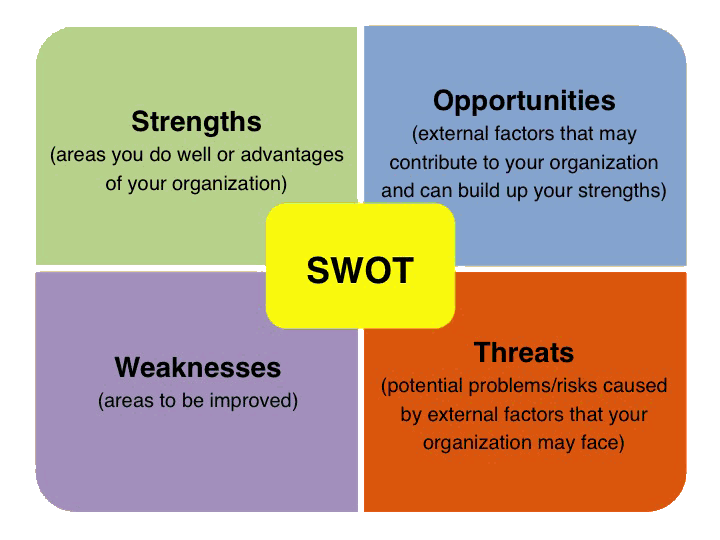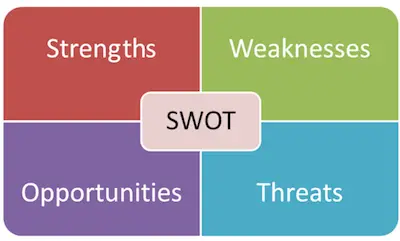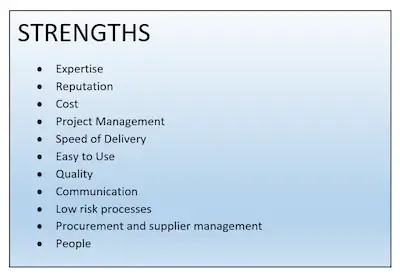SWOT Analysis
One of the many strategic-level analysis is the SWOT Analysis. The SWOT stands for:
- Strengths - These refer to the stronger points inside an organization. These are the things in which the organization is so good that it's hard for the competitors to copy.
- Weaknesses - These refer to the weakest points inside an organization. These are usually the things that are difficult to overcome such as outdated equipment, poor image, poor location, among others.
- Opportunities - These include new markets opening up, external opportunities, among others.
- Strengths - These refer to the stronger points inside an organization. These are the things in which the organization is so good that it's hard for the competitors to copy.
- Weaknesses - These refer to the weakest points inside an organization. These are usually the things that are difficult to overcome such as outdated equipment, poor image, poor location, among others.
- Opportunities - These include new markets opening up, external opportunities, among others.
There's no question that a SWOT analysis is a very powerful way that allows you to evaluate your company or project.
What Is The SWOT Analysis Definition?
Simply put, the SWOT meaning is incredibly simple and very effective. The SWOT analysis is just a technique that companies can use to determine and define their Strengths, Weaknesses, Opportunities, and Threats – SWOT.
While in most cases, the SWOT analysis is used at the organizational level, it can also be used in individual projects within a single department.
While in most cases, the SWOT analysis is used at the organizational level, it can also be used in individual projects within a single department.
Understanding The SWOT Analysis Process
As we already mentioned above when we mentioned the SWOT meaning, we told you that SWOT stands for Strengths, Weaknesses, Opportunities, and Threats. SO, let's take a closer look at each one of these elements individually.
#1: Strengths:
This is the first element of SWOT analysis and as you can easily understand, this element refers to the things that your company or project do especially well.
One of the things that you need to keep in mind about this element is that it can include both intangibles such as your company's brand attributes as well as tangibles such as a unique selling proposition of a specific product line. But your strengths can also include a great engineering team or a strong leadership, for example.
One of the things that you need to keep in mind about this element is that it can include both intangibles such as your company's brand attributes as well as tangibles such as a unique selling proposition of a specific product line. But your strengths can also include a great engineering team or a strong leadership, for example.
#2: Weaknesses:
The truth is that when you identify your strengths, you will probably also be able to identify your weaknesses.
Simply put, this element of the SWOT analysis is related to the aspects within your organization or company that are holding you back. These elements may include budgetary or financial limitations or even a shortage of skilled people.
One of the things that you also need to include within your weaknesses may come from the direct comparison with other companies in your industry.
Simply put, this element of the SWOT analysis is related to the aspects within your organization or company that are holding you back. These elements may include budgetary or financial limitations or even a shortage of skilled people.
One of the things that you also need to include within your weaknesses may come from the direct comparison with other companies in your industry.
#3: Opportunities:
As a business owner, you sometimes feel that you could be doing more. But doing more how? And where? The reality is that some companies just can't keep up with the volume of leads that are generated. So, here's an opportunity that you are missing and that you need to take. Another opportunity may come when your company is developing a new product that will allow you to open the door to new demographics or markets.
Ultimately, this element of the SWOT analysis involves looking at everything that you can do to grow your company or improve sales.
Ultimately, this element of the SWOT analysis involves looking at everything that you can do to grow your company or improve sales.
#4: Threats:
This is the last element of the SWOT analysis. Within this element, you should include everything that poses a risk to both your company as well as to the likelihood of growth or success.
This category may include a wide variety of things including financial risks, changes in regulatory law, emerging competitors, among others. Everything that may virtually jeopardize the future of your project or company should be included here.
This category may include a wide variety of things including financial risks, changes in regulatory law, emerging competitors, among others. Everything that may virtually jeopardize the future of your project or company should be included here.
Bottom Line
As you can see, the SWOT analysis gives you a great overview about your company, the good things that you have been doing and the weaknesses that you need to work on. Besides, it doesn’t forget about the opportunities that you may take to grow as well as be aware of all the risks that can put your company in danger.





